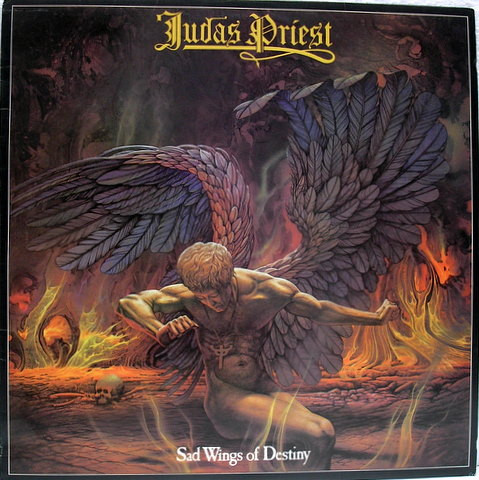„The Ripper“, from Judas Priest’s 1976 album Sad Wings of Destiny, is a sinister and theatrical take on the infamous figure of Jack the Ripper. Unlike Victim of Changes, which delves into personal heartbreak and existential regret, The Ripper is a first-person horror narrative, drenched in menace, suspense, and pure evil.
With its sharp, stabbing riffs and Halford’s piercing falsetto, the song paints a chilling picture of a predator lurking in the fog-covered streets of London. The lyrics embody the mind of the killer himself, creating a sense of dread and inevitability as he stalks his victims.
Musically, the song is short, aggressive, and direct, acting as a proto-speed metal track that showcases Judas Priest’s growing intensity and theatrical flair.
Overview
At its core, The Ripper explores:
- Serial murder and psychological horror.
- The perspective of the killer, making the listener the prey.
- Gothic and Victorian horror influences, evoking Jack the Ripper.
- A sense of inescapable doom and terror.
The song acts as a metal horror story, embracing the dark theatricality that Judas Priest would later perfect.
Narrative Structure
1. The Introduction (A Warning to the Listener)
- The song opens with an eerie, ominous guitar melody, setting the stage for horror.
- The narrator (Jack the Ripper) immediately warns the listener:
„You’re in for surprise, you’re in for a shock!“ - The use of direct address makes the song deeply unsettling, as if the killer is speaking directly to the listener.
- Theme: The killer is not just an observer—he is a hunter, and we are the prey.
2. The Hunt (Fear & Stalking)
- The Ripper describes his methodical approach to murder:
„There’s a devil in me, a monster I am.“ - He revels in his own reputation, aware that his name alone spreads terror:
„I’m sly and I’m shameless, nocturnal and nameless.“ - The lyrics convey a sense of inevitability—his victims have no chance to escape.
- The sharp, cutting guitar work mimics the slicing of a blade, enhancing the feeling of panic and doom.
3. The Kill (The Inevitable Fate of the Victim)
- The song escalates in intensity, mirroring the moment of the attack:
„When you least expect me, and you turn your back, I’ll attack!“ - The sudden, violent nature of the lyrics reflects the brutal nature of Jack the Ripper’s real-life killings.
- The Ripper takes pleasure in his victims’ terror, reinforcing the song’s horror elements.
4. The Aftermath (Fear & Legend)
- The Ripper’s mocking tone remains until the end, emphasizing his dominance and invincibility:
„Or am I just a figment of your mind?“ - This suggests that the fear he instills is just as powerful as the crimes themselves.
- The song ends with the killer still at large, leaving the listener in suspense, knowing the murders will continue.
Themes & Symbolism
1. The Horror of the Unknown
- The Ripper thrives in the shadows, creating an atmosphere of dread and paranoia.
- The fear of an unseen killer resonates deeply—he could strike at any time.
2. The Mind of a Predator
- Unlike most crime-based songs, which focus on the victims or the aftermath, The Ripper forces the listener to see through the eyes of the killer.
- The lyrics ooze with arrogance and sadistic pleasure, making the villain the centerpiece of the narrative.
3. Gothic Horror & Victorian London
- The imagery evokes gaslit streets, dark alleys, and the mythos of Jack the Ripper.
- The song captures the eerie, fog-drenched fear of 19th-century London, mirroring classic horror stories.
4. The Power of Fear
- The Ripper himself acknowledges that his legend is as terrifying as his blade.
- Even if he’s not physically present, his name alone causes panic, making his legacy of terror unstoppable.
Musical & Emotional Impact
1. The Sharp, Stabbing Guitar Riffs
- Glenn Tipton and K.K. Downing create razor-sharp riffs that mirror the Ripper’s blade.
- The staccato rhythm builds tension, keeping the listener on edge, waiting for the strike.
2. Halford’s Haunting, Falsetto Vocals
- Halford channels a theatrical, sinister performance, making the Ripper sound both gleeful and menacing.
- His high-pitched shrieks add an almost supernatural element to the character, like a ghostly killer haunting the streets.
3. The Relentless, Short Song Structure
- At just under three minutes, the song strikes fast and disappears, much like the Ripper himself.
- The sudden ending leaves the listener in suspense, reinforcing the fear that he could return at any moment.
Legacy & Influence
- One of Judas Priest’s most iconic early tracks, showcasing their theatrical and storytelling capabilities.
- Helped shape metal’s fascination with horror themes, influencing bands like King Diamond, Mercyful Fate, and Alice Cooper.
- A fan favorite, often performed live with Halford taking on a sinister, dramatic persona.
- One of the earliest examples of metal adopting a full horror narrative, paving the way for later bands to explore serial killers, mythology, and gothic horror themes.
Final Verdict
„The Ripper“ is a masterclass in heavy metal horror storytelling—delivering sharp, vicious riffs, chilling vocals, and a terrifying narrative from the killer’s own mind. It captures fear, menace, and the unstoppable force of a legend, making the listener feel trapped in the fog-drenched streets of London, hearing footsteps behind them, knowing there’s no escape.
A sinister, gothic horror anthem that proves Judas Priest’s mastery of metal storytelling.



